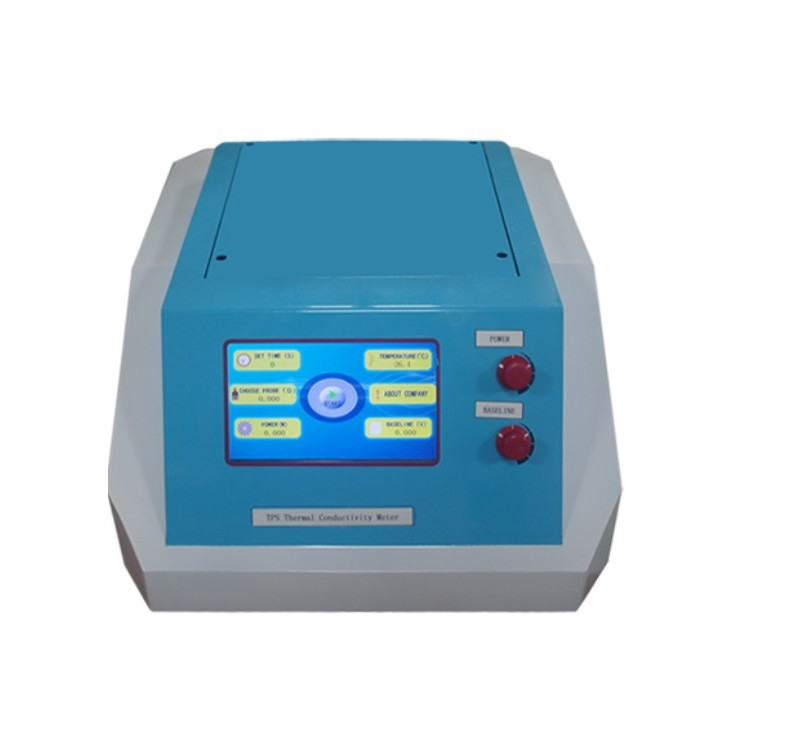
보유장비 (R&D Facility)
액체 및 고상 시편의 열전도도 측정분석 서비스
본 열전도도측정기는 ISO 22007-2 2008에 따른 다양한 재료의 열전달 특성을 측정하는 데 사용되는 최신의 Transient Plane Heat Source method로써, 열전도도를 빠르고 정확하게 측정하는 기기입니다.
- Transient Plane Heat Source method
- Standard method: ISO 22007-2 2008
- 열전도도측정범위: 0.005 ~ 300 W/mK
- 측정온도: 상온 ~ 200도 (핫플레이트 또는 오븐 사용)
측정 재료 
금속, 세라믹, 합금, 고분자, 미네랄, 복합소재, 종이, 직물, foam(표면이 부드러운 단열재 재료 및 플레이트), 미네랄 울, 시멘트 성형물, 강화유리 복합체 플레이트 CRC, cement polystyrene board, 샌드위치 콘크리트, glass - steel panels composite plates, paper honeycomb panels, 겔, 액체, 분말, granular 및 pasty solid.
작동원리
Transient Plane Source Technology(TPS)는 Hot wire method를 기반으로 개발된 새로운 열전도도 측정방법입니다(Silas Gustafsson Sweden Chalmer University of Technology). 과도 온도 가열 단계 (transient temperature heating step)의 무한 매체 디스크 모양의 열 생성 응답(infinite medium disc-shaped heat generated response)을 기반으로 측정합니다.
열원 및 온도 센서로 평평한 프로브를 사용하여 형성된 열 저항 재료. 열 저항-온도 합금과 저항 선형 관계 사이의 관계, 즉 저항의 변화를 이해함으로써 열 손실을 알 수 있으며 샘플의 열전도율을 반영합니다. 즉, 이 방법의 프로브는 합금을 에칭한 후 전도성 호일의 연속적인 이중 나선 구조를 사용하는 것이며, 이중 절연 보호 층을 갖는 전기 절연제 프로브를 사용합니다.
테스트 중에 프로브는 테스트된 샘플의 중간에 놓여집니다. 프로브를 통과하는 전류, 특정 온도 상승, 샘플 프로브의 양쪽에 동시에 발생하는 열 확산, 열 확산 속도는 재료의 열 전달 특성에 따라 달라집니다. 프로브의 온도 응답 시간을 기록하면 열전도율에서 직접 수학적 모델을 얻을 수 있습니다.
특징
- Standard: ISO 22007-2 2008.
- Direct measurement, testing time is about 5-160s, and can be set up, to quickly and accurately measure the coefficient of thermal conductivity, saving a lot of time.
- Do not suffer the effects of thermal contact resistance.
- No need special sample preparation, sample shapes without special requirements, bulk solids, only need the relatively smooth surface and satisfies the length and width of at least twice the diameter of probe can be.
- Non-destructive testing on samples, samples can be reused.
- The probe using the double-helix structure design, combined with the exclusive model, data collected on the probe using the core algorithm analysis.
- Sample stage designed, easy operation, suitable for different thickness of the sample.
- The probe data acquisition using the imported data acquisition on the chip, which is high resolution, can make the tests more accurate and reliable results.
- Host control system using the ARM microprocessor, speed is faster than traditional microprocessors, improves the processing capacity, more accurate results,
- It can be used for measuring bulk solids,pasty solid, granular solid, paste, gel, liquid, powders, coatings, thin film, thermal insulation materials.
- Intelligent freiendly human-computer interface, color LCD display, touch screen controls
- Powerful data processing capabilities. Highly automated computer processing system for data communication and reporting.
Technical parameters
|
Measure method |
Transient Plane Heat Source, Unsteady Status |
|
Measurement physical properties |
Direct access the thermal conductivity and thermal diffusivity |
|
Test object |
Solid, liquid, powder, paste, colloid, granule Sample size (for solid sample):
|
|
Test Range |
0.005- - 300 W/(m*K) |
|
sample temperature range |
Room temperature ~ 130℃ |
|
Probe diameter |
15 mm |
|
Accuracy |
±3% |
|
Repeatability |
≤3% |
|
Measuring time |
5- - 160 seconds |
|
Power supply & Total power |
220VAC, ﹤100W |

-
2025년 10월 현재, 서비스 가능합니다.DSC Advanced Model-Free Kinetics 측정분석 서비스YEONJIN S-Tech Corporation 2025-10-29 18:04:24
-
2025년 10월 현재, 서비스 가능합니다.DSC Model Free Kinetics 측정분석 서비스YEONJIN S-Tech Corporation 2025-10-29 18:05:17
-
2025년 10월 현재, 서비스 가능합니다.DSC nth Order Kinetics 측정분석 서비스YEONJIN S-Tech Corporation 2025-10-29 18:05:46
